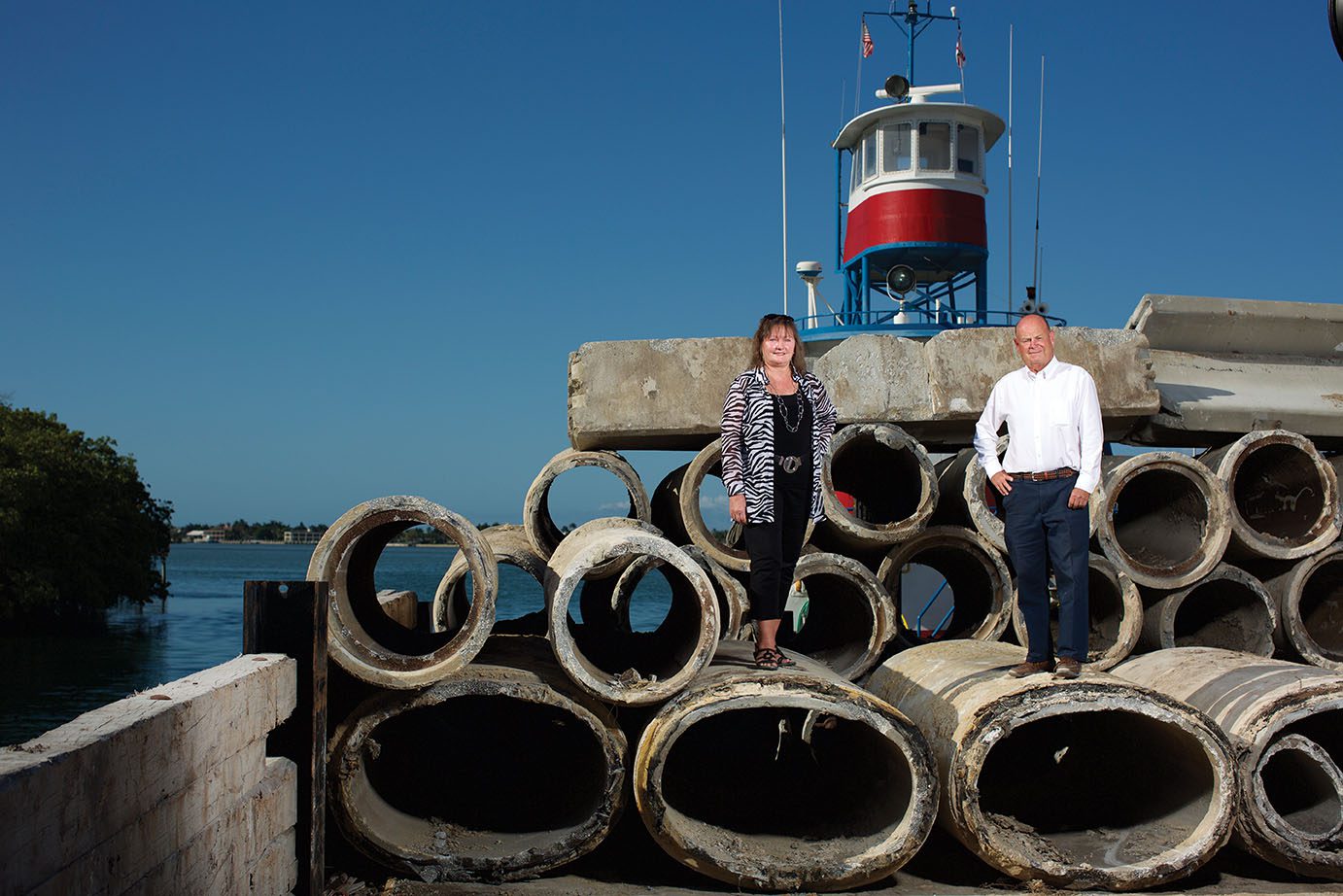Peter Flood loves to fish. You can hear it in the way he talks about his boat, Catnap, which has been laid-up for “too long” with a tedious gas tank repair. And you can see it in the photo of him holding a just-fetched-from-the-sea black grouper. In the snapshot it’s hard to tell which is bigger, the fish or his grin.
Now, Flood, a local attorney, is turning his lifelong love of fishing into a community service project that promises to bring $30 million in annual revenues to Collier County. Flood is the mastermind behind the Paradise Reef project, a multimillion-dollar endeavor to build a huge network of artificial reefs off the shores of Collier County. But he’s quick to shift the praise to his partner, longtime Collier County government employee Diane Flagg. While Flood had the idea, Flagg had the know-how needed to get contracts approved and permitting pushed through the sludge of bureaucracy.
On Jan. 9, 2015, the first reef—a giant hunk of concrete—was laid to rest on the bottom of the Gulf. As the saltwater swallowed the manmade material, Flood and Flagg felt a wave of pride—and relief. They’d done it—or at least the first part of it. Getting to this point had been a lot like embarking on a giant underwater basket-weaving project; there’d been a lot of holding of breath and weaving like mad in hopes that things would come together before the air ran out.
Finally, everything is coming together.
Flood grew up fishing with his family on Lake Erie. He moved to Naples “for a change” but adds that being able to access world-class deep-sea fishing didn’t hurt, either.
 Over the past 20 years, though, Flood began to notice that the quantity of the fish he was catching was dwindling. And even though his nautical charts indicated there were artificial reefs just off the Naples coastline, the reefs seemed to be completely barren.
Over the past 20 years, though, Flood began to notice that the quantity of the fish he was catching was dwindling. And even though his nautical charts indicated there were artificial reefs just off the Naples coastline, the reefs seemed to be completely barren.
He was right. The artificial reefs Collier County had installed in the 1980s had all but disintegrated. “They put them in fairly shallow water, and they decided to have one at each inlet, rather than one big reef,” says Heyward Mathews, a professor at St. Petersburg College and an artificial reef expert. Mathews has been working on artificial reefs for so long he’s often called just “Dr. Reef.”
“They tried to please everybody by making them accessible to as many people as possible,” Mathews says. Unfortunately, the result was that the reefs didn’t attract as many fish as they should have, and the spots where they were placed weren’t ideal. In just a few decades’ time, the reefs were basically a joke between fishermen and divers.
After talking to a few divers who confirmed that, indeed, the reefs were deserted, Flood got an idea.
After the Deepwater Horizon oil spill of 2010, Flood worked on a litany of BP claims cases. “I was involved with the BP claim system for a good five years, and when the settlement was reached, this fund was set up,” he says.
Called the Gulf Tourism Seafood Promotional Fund, it was a special pot of money set aside for tourism-related projects in areas impacted by the spill. Flood says the fund wasn’t well-
advertised and that he really only knew about it because of his work on other BP claims. Additionally, the window for applying for one of the grants was short, just 21 days.
It was 2012; the recession was lingering. For leaders in Southwest Florida, it was beginning to feel like things might never turn around. In an attempt to jumpstart the sluggish local economy, Collier County formed an Economic Recovery Taskforce.
One of the co-chairs of the taskforce was Diane Flagg, a 32-year-veteran of the Collier County government. Flood knew Flagg from a previous case he worked on and remembered her as a go-getter who was an “ace at getting things done.” If he was going to get his behemoth reef project off dry ground, he needed Flagg on his team.
“He said, ‘Diane, we’ve only got two weeks to get these grant applications in,’ and I said, ‘OK, we’ll do it,’” Flagg remembers, adding that she spent the next few days calling leaders and begging for meetings. Because BP would disperse money only to local governments, and technically the taskforce wasn’t a government agency, Flagg and Flood had to convince all three local governments—Collier County, the City of Naples and the City of Marco Island—to apply concurrently for funds.
But that was just the first step. “It wasn’t just getting all three governments to submit grants; it was getting one marine contract that could be utilized by three different governments. So even though there are three governments involved, it functioned like one project,” Flagg says.
Each municipality got its grant application in before the deadline, and when all three were approved, Flagg and Flood knew they were in business. For the next two years, the duo filed forms, attended meetings and worked with regulators. Flood had the legal chops and Flagg knew her way around city hall. “Our permits from the Army Corps of Engineers were approved in 13 months, which is unheard of,” Flagg says.
The reef project will eventually span all three municipalities, with reefs ranging from 12 to 30 miles from shore. They’ll be built in large clusters, with small “reef modules” surrounding the main “legacy reefs.” To make sure this reef project didn’t repeat the mistakes of the previous one, Mathews surveyed the bottom and advised the team on where to place the concrete. With “Dr. Reef’s” guidance, Flagg and Flood feel certain these reefs will last a lifetime—and hopefully longer.
“That’s actually why we used concrete, too,” Flagg says. “A ship [like the surplus military vessels that have been sunk off Lee County and the east coast of the state] only lasts 80 to 100 years; concrete can last 800 to 1,000 years.”
Plus, concrete is something Southwest Florida has in abundance. Whenever a new development goes in or a street is widened, culverts have to be modified to handle the increase in runoff. The concrete that previously made up that culvert is hauled off to the landfill. There, it sits and sits and sits.
 “We’re taking the stuff that would otherwise be in the landfill, and FPL is delighted; we’re taking their old poles,” Flood says. “It’s a win-win: This stuff doesn’t go into the landfill, and it creates habitat for fish. These days, Diane and I drive down the street and look for junk concrete.”
“We’re taking the stuff that would otherwise be in the landfill, and FPL is delighted; we’re taking their old poles,” Flood says. “It’s a win-win: This stuff doesn’t go into the landfill, and it creates habitat for fish. These days, Diane and I drive down the street and look for junk concrete.”
Using recycled concrete has helped keep the cost of this project down to a measly $3 million. The first $1.3 million came from BP; now Flood and Flagg are recruiting private donors to help with the remaining $1.7 million. Two families, the Wasmers and Footes, have bought “legacy reefs.” For a $100,000 donation, you can have your name put onto one of the reefs. As long as the reef is there, your name will show up on nautical charts.
Flagg says this is the largest artificial reef project in the Western Hemisphere, but Mathews says that honor would go to a reef off of Norfolk, Virginia. However, if the proposed Paradise Reef were to become an ongoing project—which is what Mathews recommends—it could someday reach that milestone.
“I hope it won’t just be a flash in the pan, that they put the reef down and then they’re done,” he says. As reefs evolve, they serve different purposes. A brand-new artificial reef provides habitat for barnacles and bottom-dwelling algae, both of which attract fish. “Over time, those start getting replaced with things like sponges and corals, things that don’t supply as much food for fish but are longer-lasting.” This is why older reefs are often not the most populated.
Pinellas County has been building reefs incrementally for years; Mathews says it’s a model Collier County should consider. Pinellas even has a barge devoted to regularly hauling materials out to sea.
A dedicated barge is a little beyond the scope of what Flood and Flagg have planned—at least at this moment. “Our next step is to work on more fundraising, to get [a fundraising] event going for next season,” Flood says. The team is also working on producing a documentary film about the project. Pure Image Productions (which is owned by the same family that owns the tourism company Pure Naples) has formed an agreement with PBS to have the documentary shown nationwide. “We want it to be a blueprint for other areas that are thinking about a project like this,” Flagg says. However, the film is adding an additional $500,000 to the project’s bottom line.
But Flood and Flagg aren’t worried about raising enough money to cover everything. After all, they’ve come this far with astounding efficiency. Without a single public dollar, the pair has deployed 19 500-ton reefs. They’ve also gotten the word out about the project. Divers are already canceling their weekend Keys trips and staying in Collier to explore the new sites. Pure Naples is even considering adding a dive boat to its offerings for next season.
“Within two hours of deployment, there are fish on the reef,” Flagg says. She adds that after a week the reef is practically teeming with life. That timeline may seem unbelievable, but Mathews verifies it’s true. And it’s the perfect metaphor for this project. In record time Flagg and Flood have brought new life—and hopefully new tourism dollars—to Collier County.





